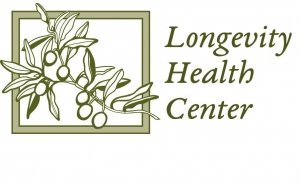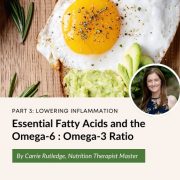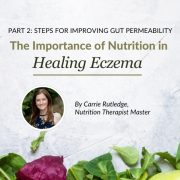The Importance of Nutrition in Healing Eczema
Part 1: Lowering Inflammation
By Carrie Rutledge, Nutrition Therapist Master
The “Why?” Behind this Series
I am the proud mother of a healthy five-year old girl who began struggling with Atopic Dermatitis, or Eczema, at 3 years of age. I approached this chronic inflammatory disease by exploring the root cause, instead of with topical steroid creams that may relieve symptoms but never address the fire inside. Although the Eczema took almost a year to heal (True healing is rarely a quick fix), with many setbacks, we have finally gotten to a place in which her body can withstand assaults and not break out into an itchy, uncomfortable rash.
Over the course of this 4-part series, I will share with you my protocol for healing my daughter’s Eczema through diet, supplements, and herbs. Although there are other parts of the protocol that I will not cover, I will be giving you some wonderful tools to get you on your way to healthy skin.
As always, everyone is biochemically different; however, my hopes are that this information will set the stage for recovery from a chronic inflammatory state.
What is Eczema?
According to the National Eczema Association, Eczema or Atopic Dermatitis is an inflammatory skin condition that causes dry skin, rashes, blisters, or skin infections and can leave someone at a higher risk for developing asthma or food allergies. The cause is unknown, but is attributed to genetics and environment, or epigenetics. Epigenetics is when our genes are “turned-on” by an environmental influence such as mold, heavy metals, fragrances, or chemicals. Currently there is no “cure” for Eczema and can only be managed by avoiding triggers and using topical creams or immunosuppressants.
My first question is: What is the “root cause”? As a nutritionist, I am always investigating the root cause. When my daughter was struggling with Eczema I asked myself, “Is it an allergy or an inability to detoxify appropriately?” “Is it because she was born via C-Section or because I had antibiotics when breastfeeding?” “Do we have a moldy house?”
I don’t subscribe to the idea that chronic disease happens by accident or purely through a genetic disposition. And if Eczema is an inflammatory condition, what is causing the inflammation? We all want the best for our children, and my biggest concern for my daughter was Eczema turning into asthma. I was determined to heal this condition to the best of my ability, and not by masking it with long-term creams or steroids, but through a holistic means of nutrition and herbal supplements.
The Top 4 Foods to Avoid When Combating Inflammation
When my daughter was 3, she broke out in a rash on the backs of her knees and in the creases of her arms. As a Nutritional Therapist I was already feeding her a healthy diet, so how could this happen? Was it even Eczema, or could it be some sort of allergy? I went down the rabbit hole into a year-long battle of getting a diagnosis, a prescription cream (or a band-aid if you will) and still no answers as to why my healthy child had inflammation of the skin.
I quickly learned that Eczema is a chronic inflammatory skin condition and can range from mild to severe. There is no “cure” for Eczema, and experts are not aware of the cause, but they do believe it is a combination of genes and environmental triggers or epigenetics. The skin is the largest organ of the body and is involved in many important functions including protection from the external environment and as an excretory organ. That’s right, many of the toxins your body is harboring (heavy metals, pesticides, drugs, steroids, and cytokines) are excreted through the skin. For this reason, having healthy skin is going to require the body to be less toxic.
Nutrition is of the utmost importance when healing Eczema. In fact, healing any skin condition requires a nutrient dense, whole-food diet. According to an eighteen-year study, the consumption of ultra-processed foods in America, consisting of fast food, ready-to-eat meals, sweets, salty snacks, canned soups, and breakfast cereals, has increased from an already high 53.5% in 2001 to 57% in 2017%. Although my daughter did not eat an ultra-processed diet, she did eat many of the foods that would be under a list of common allergens such as, wheat, dairy, eggs, peanuts, and tree nuts, so I began the process of removing these foods from her diet.
I do not suggest removing all the above foods at once, especially if you are trying to help a small child with Eczema. I am going to briefly touch on the four most important foods to eliminate when you are trying to bring down inflammation quickly.
Gluten
Gluten intolerance and Celiac Disease is on the rise and has seen a drastic increase since 1990. The wheat grown in the United States has changed drastically in the last 70 years. We now grow a genetic variant called Semi-Dwarf wheat. This type of wheat is grown so that farmers can harvest more product in less time and under tough conditions. This may be why someone with a gluten sensitivity may have symptoms in the United States, but not in Europe. Furthermore, gluten upregulates Zonulin which is a protein that regulates the tight junctions or barrier in the cells of the gut. When the tight junctions of the gut become disturbed, the permeability of the gut lining allows for foods and toxins to pass into the bloodstream causing a whole host of problems. This is called “leaky gut” and can result in chronic inflammatory disease.
I strongly recommend anyone with an inflammatory condition to remove gluten for at least ninety days. When you remove gluten, you will also be removing many processed foods and foods sprayed with pesticides, precisely glyphosate. The great news about removing gluten is it is extremely accessible to find healthier, gluten-free options. It should be noted that many gluten-free foods are still heavily processed; therefore, you will need to read labels thoroughly.
Conventional Dairy
Not all dairy is created equal, and replacing dairy with a vegan beverage that is ultra-processed and high in oxalates isn’t the answer either. For this reason, it is important to choose your dairy wisely. Look for dairy in which the animal is pasture raised, organic and preferably raw. If we look to the French, who have diets high in saturated fats, but low incidences of chronic inflammatory disease, we learn that dairy stimulates an enzyme in the digestive tract called alkaline phosphatase (IAP) that is responsible for detoxifying lipopolysaccharides, a pro-inflammatory microbe. Furthermore, dairy raised responsibly has a high nutritional value as it is a complete protein with vitamin A, D, folate B12 and butyrate which stimulates intestinal IAP. Butyrate plays an important role in the digestive tract by supplying the colon cells with energy lowering inflammation and supporting immunity.
Dairy that is acceptable when targeting Eczema and inflammation would be imported raw cheese, raw milk from a local trusted farmer, and butter or ghee for cooking. In fact, pastured ghee and butter is a much better choice for cooking as opposed to vegetable oil because saturated fats are more stable to heat and are not prone to oxidation. If you do choose to avoid dairy altogether, I suggest making your own almond milk from organic almonds or finding a brand such as MALK that does not have synthetic gums, nutrients, or stabilizers.
Artificial Dyes and Flavors
Last summer, I got my daughter’s Eczema under control and then she started pre-school. It wasn’t long until the Eczema showed up all over the back of her legs. The teacher sent a note home one day saying that my daughter couldn’t focus, not only that she was always crying within an hour of picking her up. I finally asked the teacher if they were giving her any food at school besides what I was sending in for snacks and was told students get a skittle every day when they leave the classroom. That alone was enough to send her into a skin flare up, as well as emotional outbursts. For this reason, I don’t budge when it comes to artificial dyes for my child. Not only are artificial dyes banned in Europe, but studies also show that they are linked to hyperactivity, hypersensitivity, and tumors in children. Luckily, there are plenty of treats available that use safe ingredients for coloring. Some of my favorites are Giggles, Unreal, Black Forest Organic, Trader Joe’s Gourmet jellybeans, TruSweets Candy Canes, King Arthurs Frosting and YumEarth Organic Lollipops.
Vegetable Oils
When we want to know which oils to cook with, we can once again look to the French, who use lard, tallow, ghee, butter, and olive oil. The fact is, the French, Italians and Spanish are the biggest consumers of saturated fats, but are leading in health outcomes. In the U.S. vegetable oils have replaced butter, ghee, and animal fat as the most used cooking oil in the last century, and we have never been sicker.
The refining process of vegetable oil is a process that requires bleaching, degumming, and deodorizing to make these oils edible. Studies show that cold-pressed vegetable oils contain pesticides, PCBs, and PAHs which are all considered to be hazardous chemical contaminants. Furthermore, vegetable oils are high in omega-6 fatty acids which promote the inflammatory response. Studies show that reducing omega-6 fatty acids and increasing omega-3’s is effective in combating inflammation. Unfortunately, most Americans have a high ratio in favor of omega-6’s, which is associated with increased inflammation, allergies and autoimmune issues.
Ways to reduce your omega-6 intake and increase your omega-3’s:
- Eat more wild-caught fish, including salmon, sardines, anchovies, scallops, shrimp, and bass.
- Plant-based sources such as flaxseeds, chia seeds, and walnuts are good, but not as bioavailable.
- Avoid vegetable oils by cooking with animal fats, ghee, cold pressed olive oil, butter, and coconut oil.
- When eating out, use a restaurant tracker to find better choices such as Seed Oil Scout or Localfats.com, which will guide you toward restaurants that cook with healthy fats.
- Avoid fast food whenever possible.
- When traveling, pack healthy snacks and research healthy restaurant options.
- Read labels for added fats such as canola oil, soybean oil, or sunflower oil.
- Buy pasture raised eggs and meats.
- Take a quality Omega-3 supplement such as Barleans, Cod Liver Oil or OrthoMega.
Keep in mind that healing from inflammation is not a quick fix. It takes patience and a dedicated commitment to looking and feeling better. If you begin by taking steps to eliminate gluten, conventional dairy, artificial dyes, and vegetable oils, you will begin to reduce the inflammatory load on the body and skin will begin to heal.
Tune in for Part 2 of this series on Gut Permeability and Chronic Inflammation










